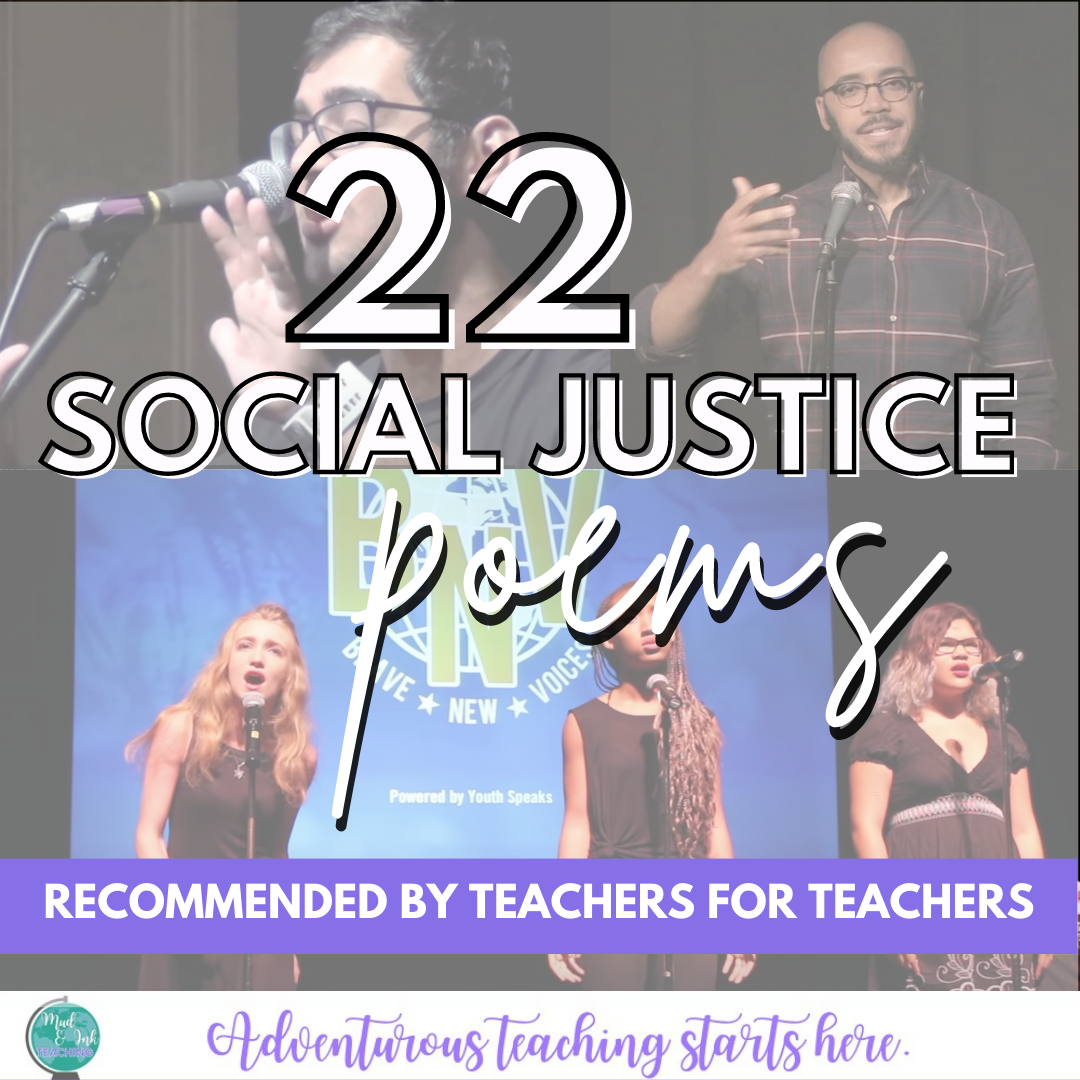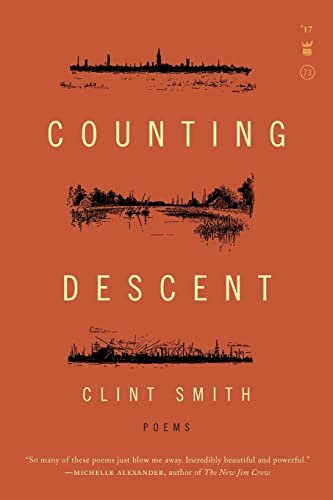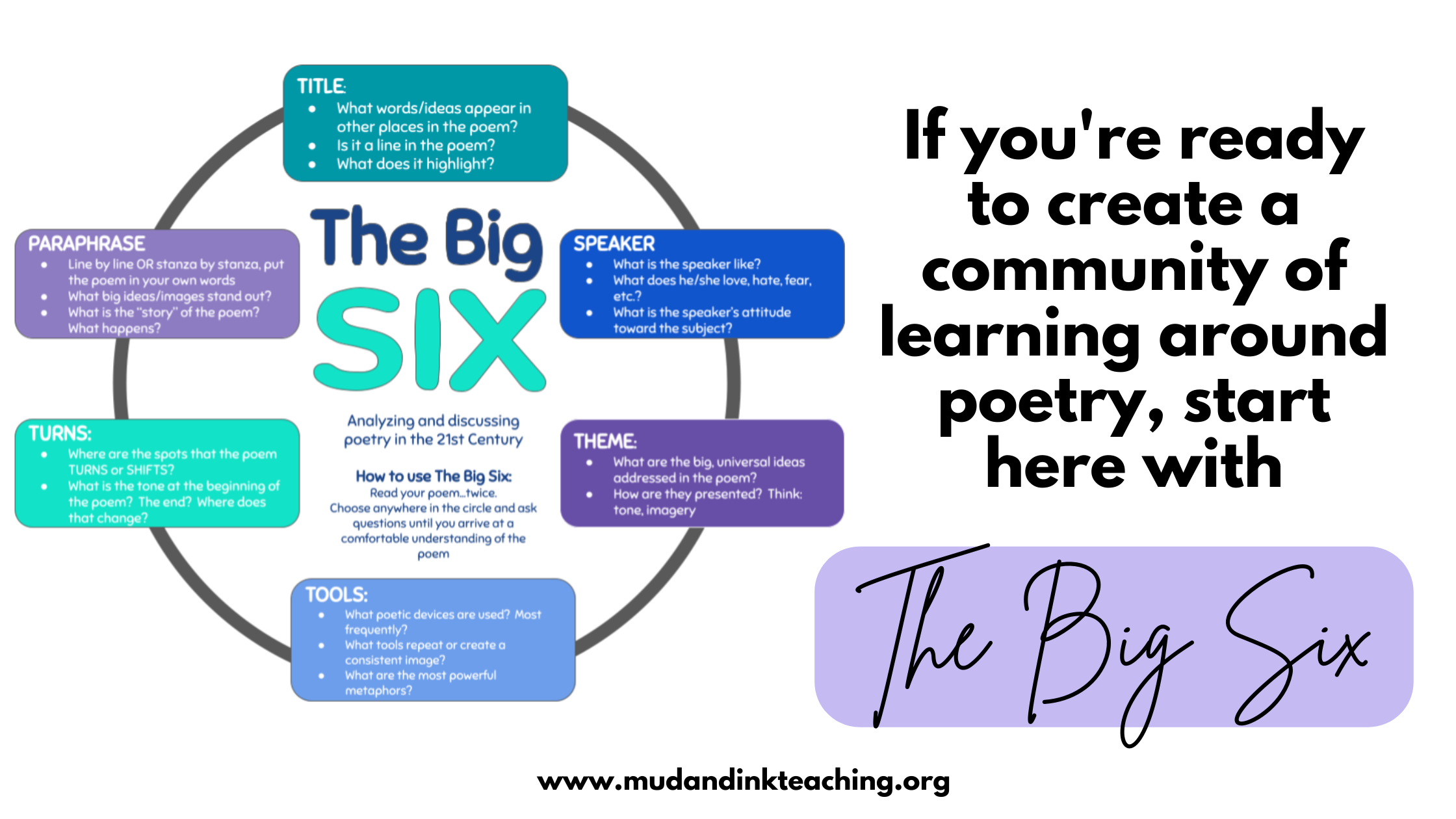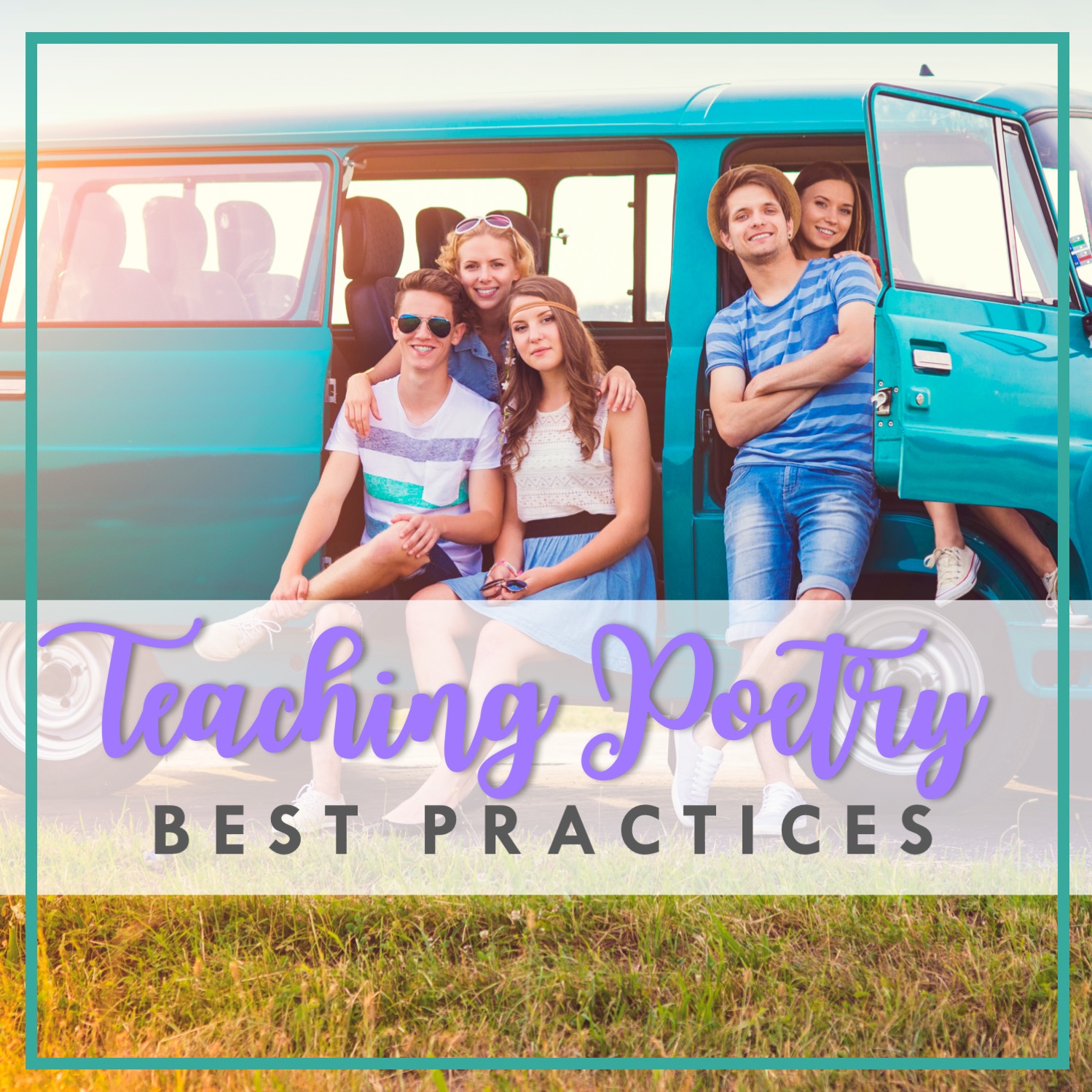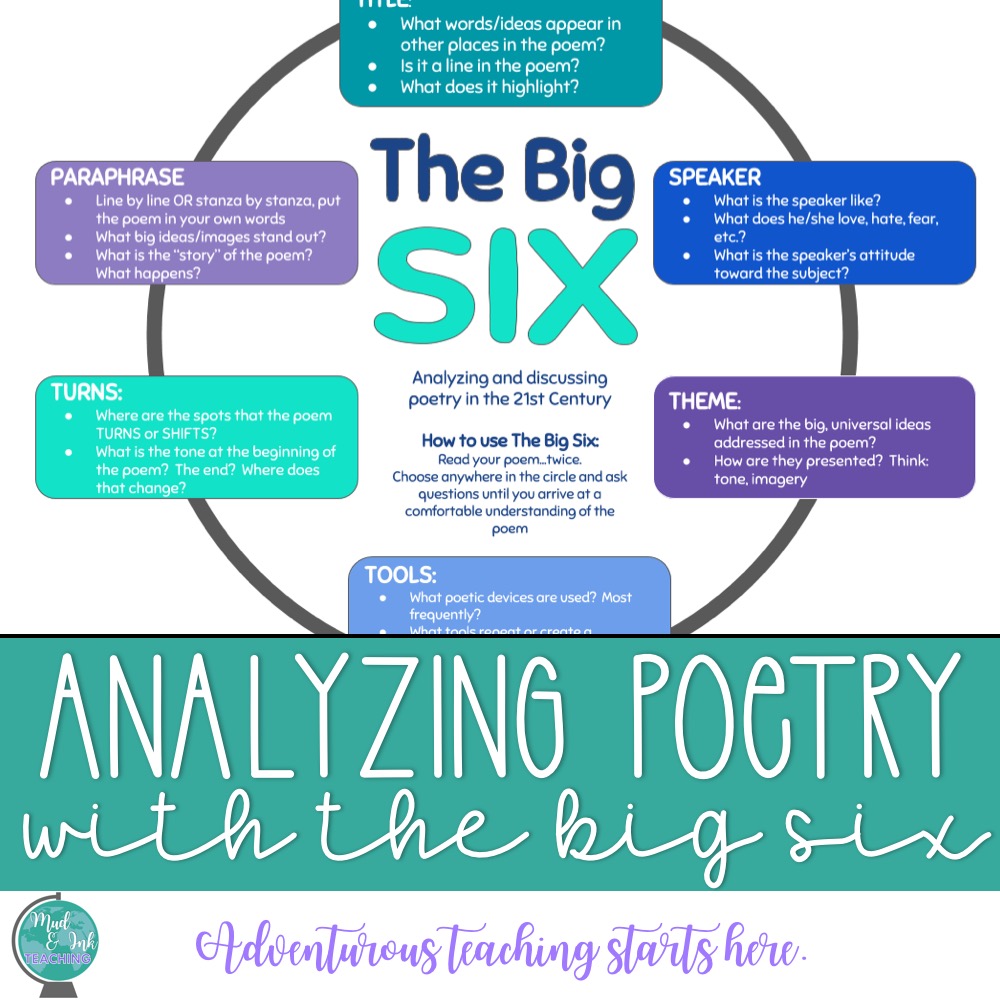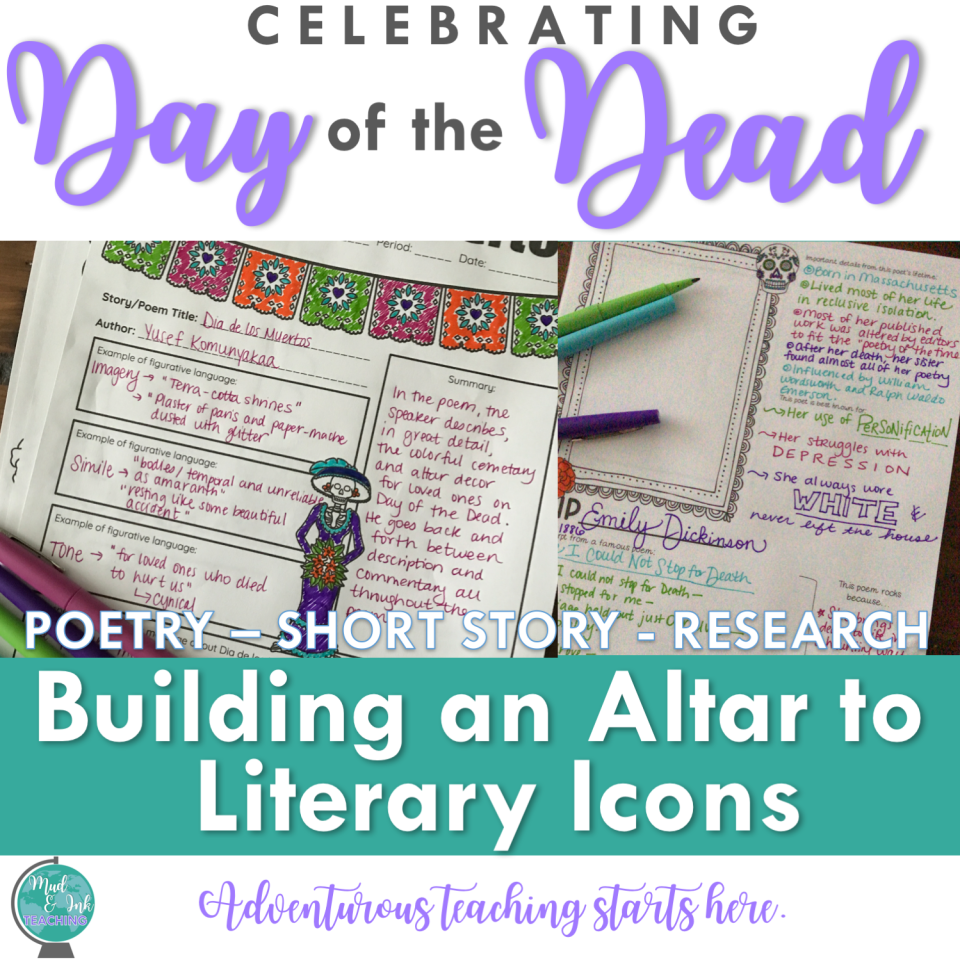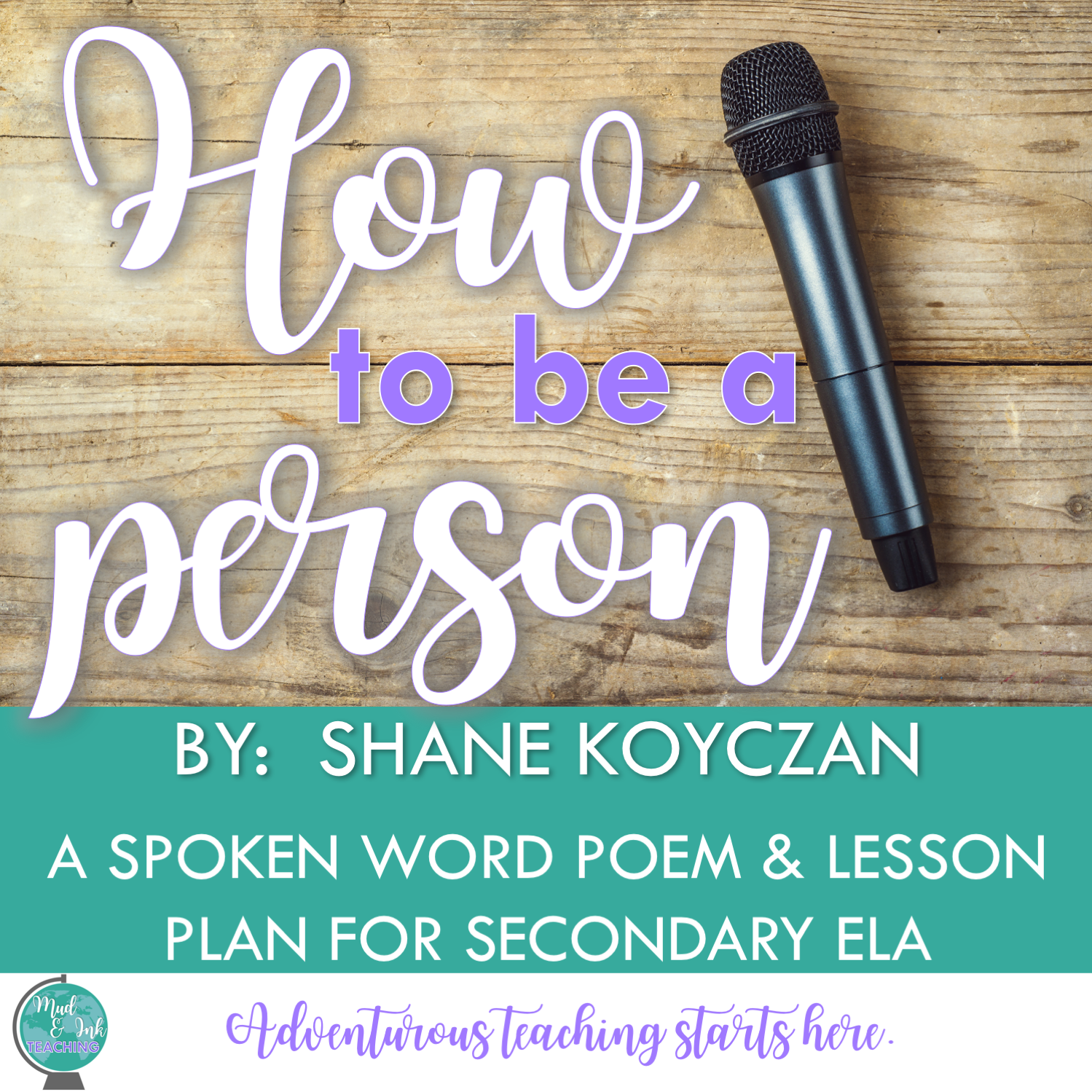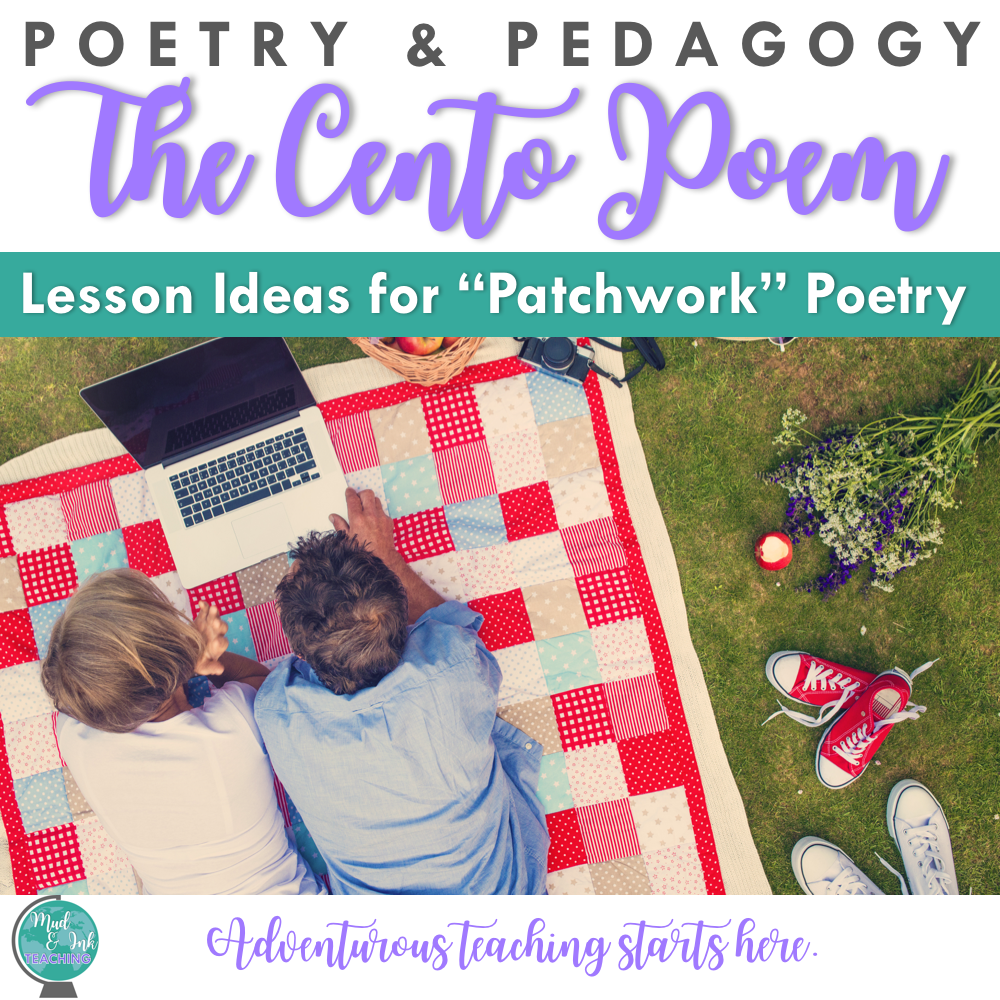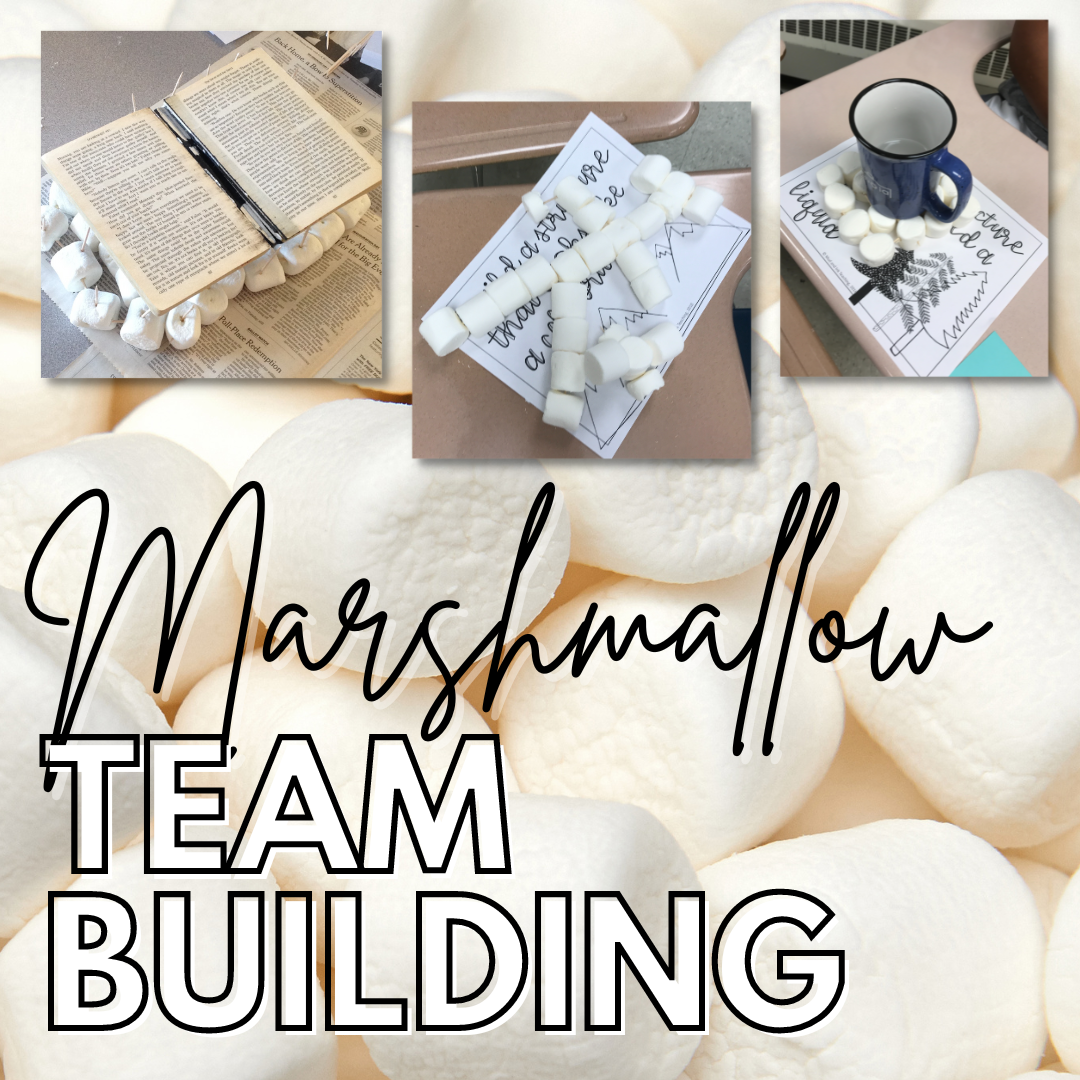
ADVENTUROUS TEACHING STARTS HERE.
22 Teacher Favorites: Poems for Social Justice
Poetry is one of my favorite vehicles to have these critical thinking discussions about social justice. The voices in poetry are so raw, real, and products of the moments from which they came. This list of 22 came from talking to teachers online about their favorites to use in the classroom, as well as my own experience teaching poetry and creative writing.
Through poetry and song, many important movements have been carried through the power of the artistic spoken word. As we work to bring critical thinking and social justice into our classrooms, we not only are providing a powerful content area for skill building but also actively working to support the social and emotional learning of our students as they attempt to figure out the complicated world in which they live.
Poetry is one of my favorite vehicles to have these critical thinking discussions about social justice. The voices in poetry are so raw, real, and products of the moments from which they came. This list of 22 came from talking to teachers online about their favorites to use in the classroom, as well as my own experience teaching poetry and creative writing.
If you’re not sure what do to with a poem, I can help you sort that out:
IDEAS FOR A THEMATIC GROUPING OF POEMS:
Study a group of poems under the same Essential Question and work on building their literary analysis skills using The Big Six
Use this list to update or supplement your poems for Poetry March Madness
Use these poems to supplement an already existing novel unit as a missing voice, a voice to add complexity, or to mirror a character in the novel
Use these poems to create a Digital Poetry Choice Board
Use these poems for imitation: read, discuss, then attempt to recreate a style, a turn, a particular poetic device, etc.
And if you’re ready for an even deeper dive into the power of poetry, I’d love to have you join us in the Teaching Poetry & Creative Writing Workshop! It’s completely virtual and asynchronous, so come in anytime and gain dozens of new ideas and insights into your own practice.
And now, on to the list! Be sure to leave a comment below with additional suggestions and your own experience teaching these poems — your work is so inspiring!
“The Hill we climb” by Amanda Gorman
This poem was hot in the spotlight for the Presidential Inauguration of 2021, but it’s power has not lessened since then. I love the versatility of this poem: study it as a poem in isolation or look at it as an argument with a rhetorical analysis angle! If you need a lesson plan for analysis, I’ve got you covered:
2. A Wreath for Emmett Till
Picture books can be an amazing way to engage students in a lesson, and several teachers have reported that this one if a brilliant overlap between poetry and social justice.
3. “This is America” from childish gambino
This one is not recommended for younger students, but if you have some older students ready to dig into both the poetry of this song and the visual experience of the music video, you’ll have one of the most engaging, important lessons of your career.
4. “LET AMERICA BE AMERICA AGAIN” BY LANGSTON HUGHES
Of all Hughes’ poems, this one was always the one that most resonated and moved my students. It’s rich with imagery and allusion and I recommend taking your time with this one — it’s not a single class period lesson.
5. “IF WE MUST DIE” BY CLAUDE MCKAY
This poem is haunting and a beautiful study in tone and theme. I especially enjoy Kevin Young’s discussion of the poem and his beautiful performance, too.
6. “CITIZEN ILLEGAL” BY JOSE OLIVAREZ
I’ve had the true pleasure of meeting Jose Olivarez back in my days of working with Young Chicago Authors and Louder Than a Bomb, and I can say for certain, this work resonates with students. It’s certainly powerful for me, but whenever I put his work in front of students, something magical truly happens.
In this stunning debut, poet José Olivarez explores the stories, contradictions, joys, and sorrows that embody life in the spaces between Mexico and America. He paints vivid portraits of good kids, bad kids, families clinging to hope, life after the steel mills, gentrifying barrios, and everything in between. Drawing on the rich traditions of Latinx and Chicago writers like Sandra Cisneros and Gwendolyn Brooks, Olivarez creates a home out of life in the in-between. Combining wry humor with potent emotional force, Olivarez takes on complex issues of race, ethnicity, gender, class, and immigration using an everyday language that invites the reader in. Olivarez has a unique voice that makes him a poet to watch.
7. “NOT AN ELEGY FOR MIKE BROWN” BY DANEZ SMITH
This is a beautiful and gut-wrenching piece about the disproportionate attention paid to the death of Black Americans. It’s very short and would work nicely in a choice board where students could tackle it independently.
8. “ODE TO THE ONLY BLACK KID IN THE CLASS” BY CLINT SMITH
This and so many more from Smith’s anthology Counting Descent deserve a spot on this list and in your curriculum. In fact, Clint Smith’s name should be on the tip of every ELA teacher’s tongue when recommending poetry about the Black American experience.
Smith explores the cognitive dissonance that results from belonging to a community that unapologetically celebrates black humanity while living in a world that often renders blackness a caricature of fear. His poems move fluidly across personal and political histories, all the while reflecting on the social construction of our lived experiences. Smith brings the reader on a powerful journey forcing us to reflect on all that we learn growing up, and all that we seek to unlearn moving forward.
9. “NATIVE TONGUE” BY MICHA BOURNES
This poem is a fascinating look at the colonization of language and othering that’s been done to Black speech.
10. “ORAL TRADITION” BY WILLIAM NU’UTUPU GILES & TRAVIS T.
William Nu’utupu Giles is an afrakasi Samoan writer, and this poem focuses on the passing down of stories and traditions through spoken word for thousands of years.
11. “SOMEWHERE IN AMERICA” FROM BRAVE NEW VOICES
In this moving poem about censorship and government control, the speakers critique the contrasting experiences of America’s youth from the books they are allowed to read in school to the histories that are not taught.
12. “BLACK GIRL MAGIC” BY MAHOGANY BROWN
In this poem about belonging and experiencing othering, Brown examines what “Black Girl Magic” looks like through her eyes.
13. “ ELEPHANT” BY JOAQUIN ZIHUATANEJO
This poem focuses on the Rwandan Genocide of the 1990’s and compares the experience of a mother losing her child to that of an elephant holding her lifeless calf. This poem is packed with emotional language surrounding a lesser taught historical tragedy,
14. “SECOND ATTEMPT CROSSING” BY JAVIER ZAMORA
In this emotional poem, Zamora depicts the immense fear, uncertainty, and loss one feels when crossing over the US border illegally.
15. “GLORY” BY COMMON
From the movie Selma, this anthem speaks of an undying hope felt by those fighting for equality during the Civil Rights Movement despite great violence and discrimination against them.
16. “BULLET POINTS” BY JERICHO BROWN
In this poem, Brown explores hate crimes in America and the violence against Black people at the hands of law enforcement.
17. “TO THIS DAY” BY SHANE KOYCZAN
Shane Koyczan, a powerful spoken word poet, delivers a close look at the lasting effects of bullying in one’s childhood.
18. “WHAT CAN A POEM DO?” BY DARIUS V. DAUGHTRY
In this poem by Darius V. Daughtry, he explores the extent to which words, and more specifically poetry, have the power to cross borders and save lives. This poem is rich with figurative language and beautiful metaphors.
19. “CHINESE 101” BY SUN LUU
Luu describes his poem with this beautiful introduction:
“An ode to my mother, to my mother tongue, and all who've given me the opportunity to exist today. This is for all those who've tried to ostracize my people, who've tried to diminish the Chinese language, and have silenced and made caricatures of Asians in America. Here, I take back my language. I take back my culture. And find the voice to speak.”
20. “MISS AMERICA” BY RAMYA RAMANA
This poem is a response to racist comments and remarks after the announcement of Nina Davuluri, an Indian American woman, as the winner of Miss America in 2014.
21. “BROWN BOY, WHITE HOUSE” BY AMIR SAFI
Safi tells the story of living in post-9/11 America and dealing with the racial stereotyping and profiling he experienced.
22. “Passive Voice” by Laura Da
In this short but powerful poem, Da draws attention to the use of passive voice when describing the history of Native American culture.
EVEN MORE RESOURCES
A Valentine's Day Activity for Middle and High School: Boost Classroom Community with Warm Fuzzies
Fighting the Winter Blues
The winter months can be a bit of a drag for classroom teachers, and morale can really start to drop this time of year (for teachers and students). This is the perfect time of year to amp up your SEL practices and foster those student-teacher and staff relationships. Who doesn’t love a little fun in the midst of winter gloom? Building community in our classrooms is so important when we think about student buy-in, but that community also extends to the faculty and staff of the school as a whole. If you’ve been looking for an idea to brighten up your classroom and build a positive school culture, these SEL Warm Fuzzies have just what you need!
Step One: Get Your Materials Ready
This activity is SO simple and requires very little to set up, and you can easily adapt the set up to meet your needs. That being said, the first thing you need is a bag for each participant. Brown paper bags work great, but if you have something similar go ahead and use those! Students will be able to decorate their bags and add a personal touch.
Once you have the bags, decide on a place for these to “live”. A bulletin board works great! You’ll staple the bags there for all to see and leave them up as long as you like.
The next step is to ready your Warm Fuzzy slips. We have some templates ready to go! Just click here and print!
Step Two: Prep Your Participants
Give students time to decorate their bags. We all know that some of our students will write their names on the bags and be done, but some may want to spend some time making their bags unique. You can set some time aside for this, let them decorate once they finish ongoing assignments, or let them take the bags home to decorate!
Next, give students the Warm Fuzzy slips, and let them begin to write their notes. Encourage students to write several notes to different classmates, and remind students that the purpose of this activity is to build community and spread some joy around. You could require each student to write a minimum amount of notes, or you could have students write a note for each of their classmates. This depends on you and the amount of time you want to spend on this activity.
It might be helpful to have some sentence starters for kids who feel stuck on what to write. And remember, the more specific the message the more meaningful the impact! Tell students to think about what stands out to them about their classmates. Maybe it’s the thoughtful discussion points someone always has, or it could be the kind gesture of always having a pencil for someone to borrow. The possibilities are endless!
Step Three: Spread the Warm Fuzzies Around!
Now it’s time to deliver the notes! You can do this all at once or over time. Either way, at the end of the process each student should walk away with an assortment of notes making them feel all warm and fuzzy inside.
A Bonus IDEA
This activity is so versatile and is something you can do multiple times throughout the year (just be sure to keep the bags 😉). You could also do this with your teacher team, your department, or your whole faculty! Hearing from our peers about the positive things they see in us is always uplifting, and don’t forget to make yourself a bag even if doing this with your students! You’d be surprised at how much those sweet words can make a difference.
If you’re looking for something to help with teacher morale, whether at the team, department, or even whole school level, this is a great activity for faculty and staff. Community is so important for our classrooms, but it’s also beneficial to build community with other teachers and staff.
IS SEL AN IMPORTANT FOCUS IN YOUR DEPARTMENT?
Then your next step it to check out my Essential Question Adventure Packs. Each pack is designed to support any classroom text that fits under the umbrella of each question — and it’s supported through an SEL focus. Here’s a peek at one of the latest packs: Why do relationships matter?
LOOKING FOR MORE LIKE THIS? HERE’S WHERE TO GO NEXT!
Add some new resources to your toolbox
"Being Human" : A Lesson for Writer's Workshop
In between the first bout and the final found, Mrs. Deleon and I had the pleasure of sitting in on a writing workshop with one of our favorite Chicago poets, Adam Gottlieb. Adam is a former LTAB competitor and, quite possibly, Deleon's long lost hippie-child :-). He brought us a gorgeous poem from the duo Climbing Poetree called "Being Human". My brain is spinning with ideas for using this poem in class, but below is how Adam shared it with us.
This weekend, the Creative Writing Club hosted the 2nd annual Regional Slammin the Sun Down competition. Eight teams competed in a slam showdown of rhymes, passion, and courage. We were THRILLED when we found out that our very own CHS - THE INK took 1st place in their bout! Julia, Maria, and Zandra performed beautifully and advanced us to the finals.
In the finals, Ashley Anderson totally brought it with her poem "Mirror", however, the poet from Merriville, IN brought it to. We took 2nd place - Ashley with a 29.3 out of 30, and her competitor with a 29.6. It was a well fought battle and the audience got to experience some pretty rad poetry along the way!!
In between the first bout and the final found, Mrs. Deleon and I had the pleasure of sitting in on a writing workshop with one of our favorite Chicago poets, Adam Gottlieb. Adam is a former LTAB competitor and, quite possibly, Deleon's long lost hippie-child :-). He brought us a gorgeous poem from the duo Climbing Poetree called "Being Human". My brain is spinning with ideas for using this poem in class, but below is how Adam shared it with us.
"Being Human" Writing Workshop Lesson
CCSS (provided by me, not Adam):
- CCSS.ELA-Literacy.L.9-10.5a Interpret figures of speech (e.g., euphemism, oxymoron) in context and analyze their role in the text.
- CCSS.ELA-Literacy.RL.9-10.4 Determine the meaning of words and phrases as they are used in the text, including figurative and connotative meanings; analyze the cumulative impact of specific word choices on meaning and tone (e.g., how the language evokes a sense of time and place; how it sets a formal or informal tone).
- CCSS.ELA-Literacy.RL.9-10.5 Analyze how an author’s choices concerning how to structure a text, order events within it (e.g., parallel plots), and manipulate time (e.g., pacing, flashbacks) create such effects as mystery, tension, or surprise.
Materials:
- Writing utensils
- Copies for all students of "Being Human" by Naima (below)
- Writing notebook/journal
- OPTIONAL: projector to share the YouTube video of the duo performance
Procedure:
- PREWRITING: Ask students to create two columns on their page. In the first column, students should brainstorm a massive list of things they think of when they consider nature: elements, animals, etc. They should write for 2-3 minutes. Next, ask if the students remember the definition of personification. In the next column, students should make a list of ways that the nature elements could be personified - specifically, ask students questions like, "What problems could these elements have? What fears? What dreams? If these elements could feel, what feeling would they have? What opinions?"
- READING: Pass out copies of the poem to the students. In our workshop, Adam performed the poem to us as we followed along. We briefly discussed the poem - what we noticed, what we liked, what surprised us.
- WRITING: Next, Adam directed us to write! We were to take inspiration from the poem and from our lists and create something. Adam gave great advice to the kids - he told them that the purpose of this writing time is not necessicarily to write the next great poem, but just to write. Students might find one great line in the time provided, or maybe even a few stanzas, but what's most important is that the students write.
- SHARING: At the end of the provided writing time, Adam asked students to share what they came up with. This time is incredibly important!
BEING HUMAN
by Naima
I wonder if the sun debates dawn
some mornings
not wanting to rise
out of bed
from under the down-feather horizon
If the sky grows tired
of being everywhere at once
adapting to the mood swings of the weather
If the clouds drift off
trying to hold themselves together
make deals with gravity
to loiter a little longer
I wonder if rain is scared
of falling
if it has trouble letting go
If snow flakes get sick
of being perfect all the time
each one trying to be one-of-a-kind
I wonder if stars wish
upon themselves before the die
if they need to teach their young to shine
I wonder if shadows long
to once feel the sun
if they get lost in the shuffle
not knowing where they’re from
I wonder if sunrise and sunset
respect each other
even though they’ve never met
If volcanoes get stressed
If storms have regrets
If compost believes in life after death
I wonder if breath ever thinks
about suicide
I wonder if the wind just wants to sit
still sometimes
and watch the world pass by
If smoke was born knowing how to rise
If rainbows get shy back stage
not sure if their colors match right
I wonder if lightning sets an alarm clock
to know when to crack
If rivers ever stop
and think of turning back
If streams meet the wrong sea
and their whole lives run off-track
I wonder if the snow wants to be black
If the soil thinks she’s too dark
If butterflies want to cover up their marks
If rocks are self-conscious of their weight
If mountains are insecure of their strength
I wonder if waves get discouraged
crawling up the sand
only to be pulled back again
to where they began
I wonder if land feels stepped upon
If sand feels insignificant
If trees need to question their lovers
to know where they stand
If branches waver in the crossroads
unsure of which way to grow
If the leaves understand they’re replaceable
and still dance when the wind blows
I wonder where the moon goes
when she is hiding
I want to find her there
and watch the ocean
spin from a distance
Listen to her
stir in her sleep
effort give way to existence
